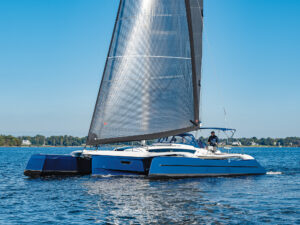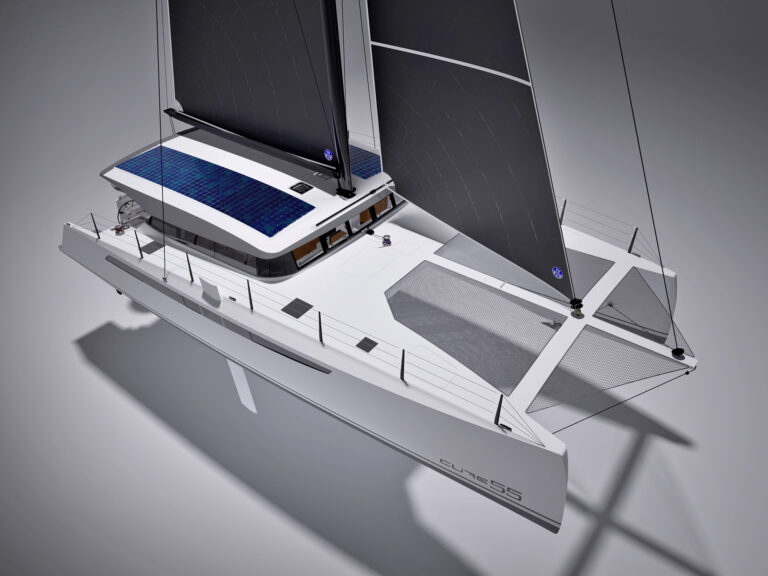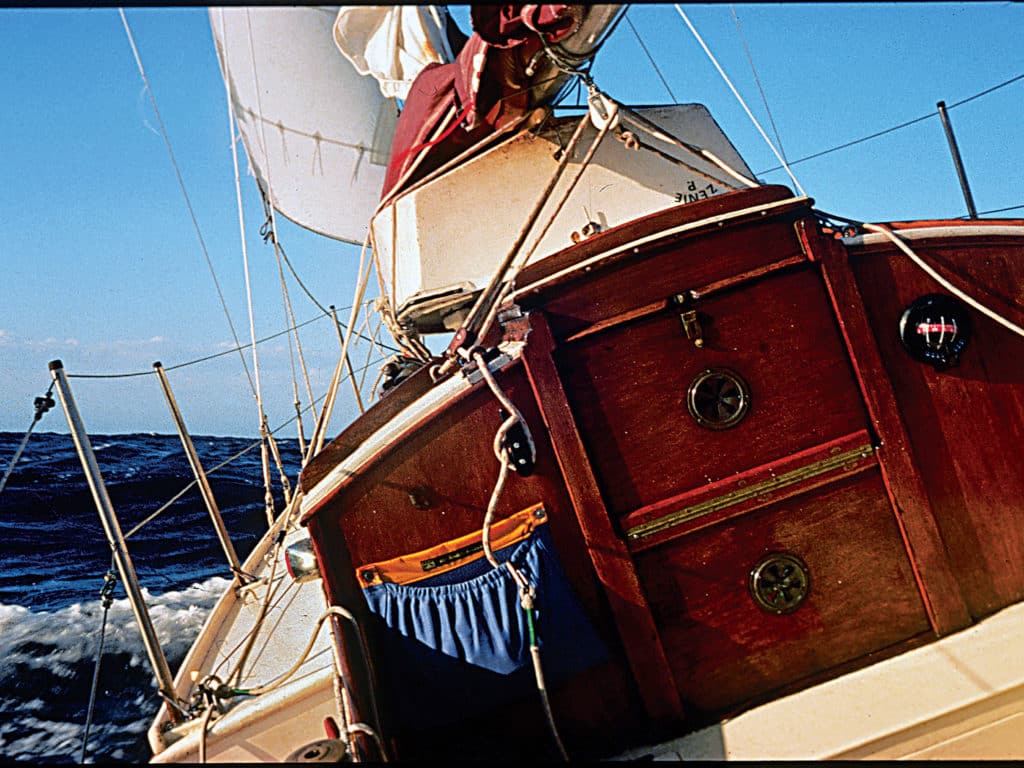
Companionway Design
While most elements of yacht design have evolved with contemporary fashion, main hatches and companionways, until recently, have inexplicably lagged behind. Since they constitute the largest holes in the boat, it seems like a strange oversight. The heavily trafficked companionway is a critical area of transition from topside to below. If it’s poorly designed, the potential for accidents is high.
Let’s start with the offset companionway, often seen in older, classic-plastic production boats. This was a design response to ketch rigs, in which the mizzenmast is often stepped in the center of the bridgedeck. To limit crawling around the spar and rigging, these hatches were offset to port or to starboard. The advantage below was a larger contiguous area for the galley, but the clear disadvantage above was a vulnerability to downflooding in a knockdown. Reliable furling gear has reduced the need to manage sail area via split rigs. And as the ketch configuration waned, so did the offset hatch.
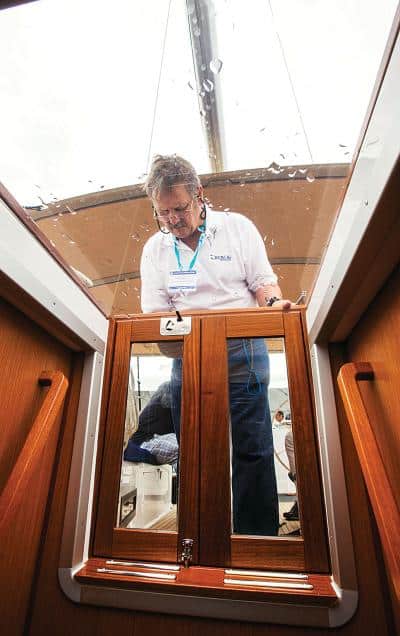
| |The saloon-style washboards on this Bavaria Cruiser 50 are stout and transparent, and stow well against the side walls of the companionway entry.|
While it’s true that many modern cockpits with wide-open sterns are self-bailing, substantial amounts of water can be funneled forward with great force when a boat gets pooped, which can happen when it’s bow down on the face of a large wave. To prevent downflooding, a balance must be maintained among cockpit size, drainage capacity, bridgedeck height and companionway strength.
Thanks to their distance above the water and the open nature of their cockpits, multihulls were incrementally moving toward eliminating bridgedecks altogether, opting instead for a sliding-door runner between the level soles of the cockpit and saloon. But enter the latest catamaran trend — the forward recessed cockpit — and suddenly their design concerns have become more aligned with those of monohulls. Making a humble concession to the vagaries of the sea, the Leopard 48 boasts a 9-inch sill aft and a commendable 12-inch rise in the forward-cockpit entry.
In theory, the higher the bridgedeck, the better. But taken to extremes, they can become difficult to step over. The Dufour 36 addresses this with a simple flip-up acrylic panel that increases the bridgedeck from 9 inches to 13 inches.
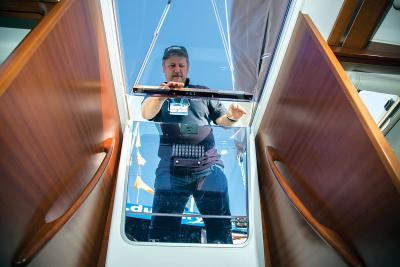
| |The ventilation holes on the Dufour 36 washboard slant downward to keep water from dripping down below.|
When it comes to sealing the vertical area of our “big hole,” a few removable washboards may suit a budget trailer-sailer, but such boards are too often found on very expensive and otherwise sophisticated vessels. To ascend into the cockpit from below, one must lift out one or even two boards (a difficult proposition in any weather, but especially in a gale); climb out into the cockpit, possibly on a heavy heel, with hands full; then place the boards back into their slots in exactly the right order and rotation. To make this slightly less inconvenient, designers changed from parallel to tapered companionway sides, which meant you had to lift the board up only a couple of inches to push it in or out. Of course, the disadvantage here is that a boarding sea can also lift the boards an inch or two and implode them. If such boards are stout enough for bluewater use, then by nature they’re bulky and heavy and take up substantial stowage area when not in use.
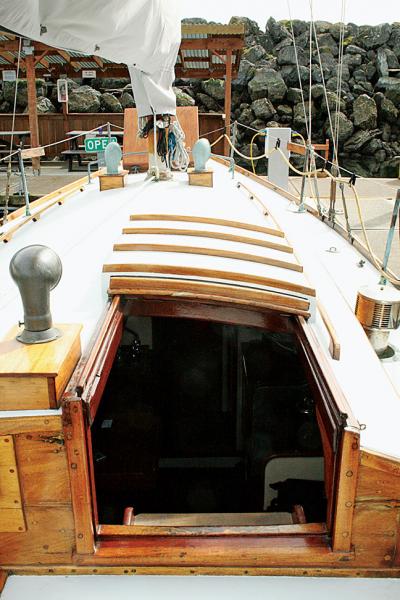
| | Though increasingly rare, the offset hatch on this old Alden Malabar was employed to reduce the clutter and confusion caused by a mizzenmast stepped in the middle of the bridgedeck.|
Many designers have gone to saloon-style side-hinged boards. The boards remain in place, which is good. But unless they’re in a recessed passageway with sidewalls on which to fasten, it’s often difficult to leave them in an open position; they’re also prone to snagging sheets. And why some are louvered is a complete mystery.
To my thinking, the perfect system offers robust, fixed boards that swing out, fold down, or drop into a recess built into the bridgedeck. They may have ventilation holes, but these either are small or can be sealed off in extreme conditions. The boards are see-though and offer good visual communication between the cockpit and below.
The shape and height of the companionway entry impacts its safety. The most vulnerable time at sea is when sleepy crew rush from below to deal with confused and cacophonous situations, such as a pre-dawn squall line. Sailors then may be exposed to slapping sheets, bone-crushing booms, or the possibility of being pitched headlong into the sea before they can be properly tethered in. The new concept of a recessed companionway entry offers initial containment side to side and protection from above until one can get tethered and assess the wind and sea conditions. The loss of cockpit space that results from pushing the main bulkhead aft to make room for the recessed entry is a small price to pay for such a safety feature.
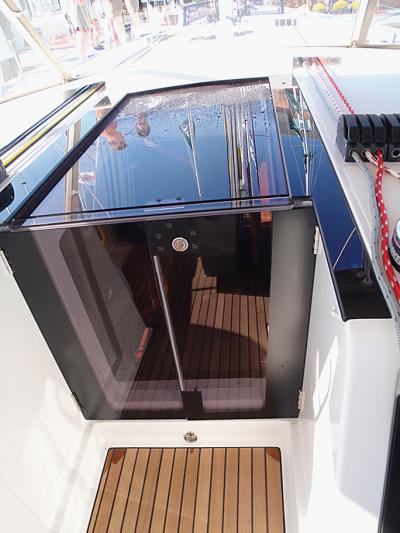
| |On the Beneteau Sense 46, the walk-through hatches are similar to regular household doors.|
Finally, we seal the horizontal area of our big hole with the sliding hatch. It needs to slide easily with little play on its rails to prevent water from floating it and gushing below. Ideally, it should be protected by a forward sea hood and, arguably, by an overhead dodger. Whereas the strength of traditional building materials sensibly limits the size of the sliding hatch, modern materials such as Lexan are often stronger than the supporting hull structures themselves. This allows designers to increase hatch size for ease of access and increased light below.
And as for the old barrel bolt that secures the sliding hatch from the inside, it must finally and forever disappear from our modern fleet. Yes, it’s important to secure the hatch so that a boarding sea can’t force it open and no one can accidentally lean on it and fall in, but the hatch should have a dual-access latch that can be operated from above and below so no one is ever locked into or out of the interior of the boat.
We owed the initial progress on many of these sound concepts to such French builders as Jeanneau, Beneteau and Dufour, which employed the innovative Goiot line of deck hardware. Many other manufacturers, including Bavaria, have since followed suit. Passport Yachts also earns high honors for the overall integration of many of these features into its boats. Passport’s fixed, clear hatchboards slide down to several determined heights before ultimately resting in a bridgedeck well, creating a sill low enough to step over easily and wide enough to sit on comfortably.
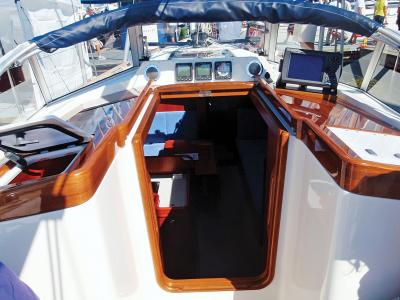
| |Aboard the Hallberg-Rassy 372, the traditional companionway treatment is compact and uses sliding hatchboards. Note the robust rails, which provide secure and welcome handholds.|
The Beneteau Sense series is pioneering new ground via a designed entry that’s more like a domestic doorway than a maritime hatch. On the Sense 55, this walk-though hatch is sealed with a horizontally hinged acrylic door that, with the touch of a button, rolls down under the cockpit sole, much like an escalator step. Only time will tell if the mechanism is reliable and if the unusually large hatch can resist the force of an angry ocean, which weighs 63 pounds per cubic foot.
The height, inclination and even shape of the companionway steps will determine if entry and exit will be safe at sea. The worst-case scenario is an almost vertical ladder of substantial height, with shallow steps, ineffective nonskid, no side containment for the feet and no ergonomically placed handholds. The best is a series of wide, scalloped steps possessing sufficient incline to walk up (as opposed to climb), enough depth to accept the whole foot on descent, and a short “hallway” enclosing the upper area of the steps. Stout handholds should be strategically placed on deck as well as below.
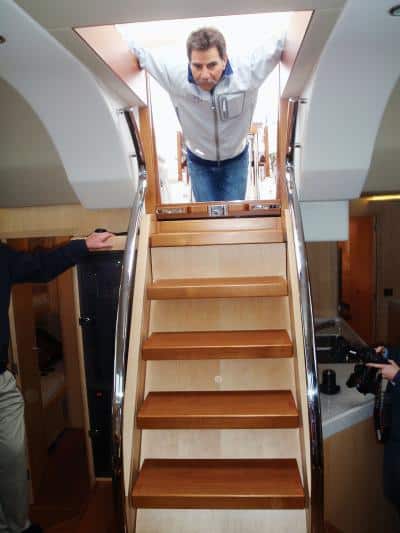
| |Everything about this Oyster 625, including the wide steps and sturdy handholds, is just right. The hatchboards drop into a generous storage well; latches can be operated from above or below.|
Where designers were once reluctant to decrease the vertical angle of the steps, so as to avoid intruding upon precious interior space, the trend toward increased interior volume, and steps that are incorporated into the engine’s access hatch, have mitigated this concern. But the length of the sliding hatch must match the interior depth of the stairwell in order to create standing headroom at the level of each step.
A small but unfortunate feature to consider is the locking system. A tempered external padlock may be strong, but the hasp that fastens it is often a flimsy affair attached with a couple of short sheet-metal screws. Although no guarantee against a determined thief, the integral key latch offers some deterrence.
In the old days of massive crews, it was said that only admirals and idiots sat in the companionway, which is why I’m always careful to address my wife as Admiral when I find her there. But with the little foot traffic that’s inherent to shorthanded sailing, the companionway’s top step is a warm and dry area from which to keep a good watch.
In the simplest terms, the core mission of the main hatch and companionway is to let the people in and keep the water out. Whether you’re considering a new vessel or upgrading an old one, pay meticulous attention to the location, design and strength of the hatch and companionway to determine how well it serves these basic purposes.
This article first appeared in the August 2013 issue of Cruising World. Click here to read more in our Design Trends series.


